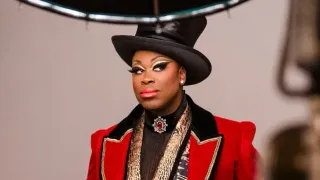March 16, 2020
Australian TV Journalist Who Met with Rita Wilson has Virus
Rod McGuirk READ TIME: 3 MIN.
An Australian television journalist said Monday he has the new coronavirus and assumes he contracted it while meeting with actress-singer Rita Wilson in Sydney.
Wilson and her husband Tom Hanks have been isolated in an Australian hospital since they were both diagnosed with COVID-19 on March 12.
Authorities said last week several contacts Hanks and Wilson had in Australia were being traced, but no other results of those efforts have been made public. Hanks had been working on a film in Australia and Wilson had concert performances in the country before they were diagnosed.
Nine Network entertainment editor Richard Wilkins said he was tested because he met Wilson at the Sydney Opera House on March 7 and again at Nine's Sydney studio on March 9. The result came back positive on Sunday.
"I'm surprisingly very well," Wilkins told Nine by Facetime from his Sydney home, where he has self-isolated since Wilson's diagnosis.
"You could've knocked me over with a feather last night when I got that call. It took me a couple of minutes to reel from the news that they gave me. But I feel fine. I feel 100%," Wilkins added.
The virus causes only mild or moderate symptoms, such as fever and cough, for most people but can be severe in some cases, especially older adults and people with existing health problems. People with mild illness recover in about two weeks, while those with more severe illness may need six weeks to recover.
The 65-year-old journalist said he could only assume that he had been infected by Wilson.
"We're assuming this is from Rita. It may not be. They've all said it could be anyone, anywhere, any time, such is the prevalence of this thing," Wilkins said.
"I was having a chat to her and that's probably my best guess as to what happened," he added.
Wilkins was one of 37 new case confirmed over 24 hours in New South Wales state, bringing the state total to 171. The increase was the largest for Australia's most populous state in a day. Authorities say at least 67 cases arrived from overseas and 44 were transmitted locally while the remainder could not be determined or were still under investigation. Australia has about 300 cases overall.
Wilkins' son Christian Wilkins was tested because he spent the night of March 10 in his father's Sydney home. The 25-year-old son is competing in the Australian version of the reality TV show "Dancing With the Stars," which is being broadcast without a studio audience because of the COVID-19 risk.
Richard Wilkins said he did not inform his son until after he had danced on the program, which is performed in a Melbourne studio on Sunday nights.
"I called him up after his show last night. He was and still is very, very upset," the father said.
"He's going to get tested in an hour and, fingers crossed, he'll be OK, which I'm sure he is," he added.
Two Nine hosts who interviewed Wilson in their Sydney studio on March 9, David Campbell and Belinda Russell, remained in isolation in their homes on Monday waiting on test results.
Hanks' diagnosis prompted an outpouring of get-well wishes in Australia and Hollywood. During the couple's isolation, Hanks has posted on social media thanking their caregivers and evoking his famous movie roles.
A recent post of a stuffed kangaroo and two slices of toast slathered in Australian fave Vegemite was captioned "Thanks to the Helpers." The advice for children to look to "helpers" in scary times is credited to American children's TV host Mr. Rogers, whom Hanks portrayed in "A Beautiful Day in the Neighborhood."
Hanks had been in Queensland state shooting an Elvis Presley biopic directed by Baz Luhrmann. The double Oscar winner plays Presley's manager, Colonel Tom Parker. The film, slated for release in October 2021, has suspended production, Warner Bros. said.
___
The Associated Press receives support for health and science coverage from the Howard Hughes Medical Institute's Department of Science Education. The AP is solely responsible for all content.






